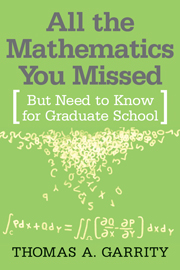Book contents
- Frontmatter
- Contents
- Preface
- On the Structure of Mathematics
- Brief Summaries of Topics
- 1 Linear Algebra
- 2 ∈ and δ Real Analysis
- 3 Calculus for Vector-Valued Functions
- 4 Point Set Topology
- 5 Classical Stokes' Theorems
- 6 Differential Forms and Stokes' Thm.
- 7 Curvature for Curves and Surfaces
- 8 Geometry
- 9 Complex Analysis
- 10 Countability and the Axiom of Choice
- 11 Algebra
- 12 Lebesgue Integration
- 13 Fourier Analysis
- 14 Differential Equations
- 15 Combinatorics and Probability
- 16 Algorithms
- A Equivalence Relations
- Bibliography
- Index
2 - ∈ and δ Real Analysis
Published online by Cambridge University Press: 11 April 2011
- Frontmatter
- Contents
- Preface
- On the Structure of Mathematics
- Brief Summaries of Topics
- 1 Linear Algebra
- 2 ∈ and δ Real Analysis
- 3 Calculus for Vector-Valued Functions
- 4 Point Set Topology
- 5 Classical Stokes' Theorems
- 6 Differential Forms and Stokes' Thm.
- 7 Curvature for Curves and Surfaces
- 8 Geometry
- 9 Complex Analysis
- 10 Countability and the Axiom of Choice
- 11 Algebra
- 12 Lebesgue Integration
- 13 Fourier Analysis
- 14 Differential Equations
- 15 Combinatorics and Probability
- 16 Algorithms
- A Equivalence Relations
- Bibliography
- Index
Summary
Basic Object: The Real Numbers
Basic Maps: Continuous and Differentiate Functions
Basic Goal: The Fundamental Theorem of Calculus
While the basic intuitions behind differentiation and integration were known by the late 1600s, allowing for a wealth of physical and mathematical applications to develop during the 1700s, it was only in the 1800s that sharp, rigorous definitions were finally given. The key concept is that of a limit, from which follow the definitions for differentiation and integration and rigorous proofs of their basic properties. Far from a mere exercise in pedantry, this rigorization actually allowed mathematicians to discover new phenomena. For example, Karl Weierstrass discovered a function that was continuous everywhere but differentiable nowhere. In other words, there is a function with no breaks but with sharp edges at every point. Key to his proof is the need for limits to be applied to sequences of functions, leading to the idea of uniform convergence.
We will define limits and then use this definition to develop the ideas of continuity, differentiation and integration of functions. Then we will show how differentiation and integration are intimately connected in the Fundamental Theorem of Calculus. Finally we will finish with uniform convergence of functions and Weierstrass' example.
- Type
- Chapter
- Information
- All the Mathematics You MissedBut Need to Know for Graduate School, pp. 23 - 46Publisher: Cambridge University PressPrint publication year: 2001



